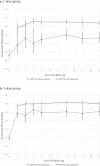HPV16 infection decreases vaccine-induced HPV16 antibody avidity: the CVT trial
- PMID: 35351898
- PMCID: PMC8964739
- DOI: 10.1038/s41541-022-00431-x
HPV16 infection decreases vaccine-induced HPV16 antibody avidity: the CVT trial
Abstract
The HPV vaccine has shown sustained efficacy and consistent stabilization of antibody levels, even after a single dose. We defined the HPV16-VLP antibody avidity patterns over 11 years among women who received one- or three doses of the bivalent HPV vaccine in the Costa Rica HPV Vaccine Trial. Absolute HPV16 avidity was lower in women who received one compared to three doses, although the patterns were similar (increased in years 2 and 3 and remained stable over the remaining 8 years). HPV16 avidity among women who were HPV16-seropositive women at HPV vaccination, a marker of natural immune response to HPV16 infection, was significantly lower than those of HPV16-seronegative women, a difference that was more pronounced among one-dose recipients. No differences in HPV16 avidity were observed by HPV18 serostatus at vaccination, confirming the specificity of the findings. Importantly, point estimates for vaccine efficacy against incident, six-month persistent HPV16 infections was similar between women who were HPV16 seronegative and seropositive at the time of initial HPV vaccination for both one-dose and three-dose participants. It is therefore likely that this lower avidity level is still sufficient to enable antibody-mediated protection. It is encouraging for long-term HPV-vaccine protection that HPV16 antibody avidity was maintained for over a decade, even after a single dose.
© 2022. This is a U.S. government work and not under copyright protection in the U.S.; foreign copyright protection may apply.
Conflict of interest statement
S.H.T. is now an employee of Merck Sharp & Dohme (MSD) Corp., a subsidiary of Merck & Co., Inc., Kenilworth, NJ, USA, but completed all work associated with this manuscript while employed at the National Cancer Institute. MSD was not involved in this work. J.T.S. and D.R.L. report that they are named inventors on US Government-owned HPV vaccine patents that are licensed to GlaxoSmithKline and Merck and for which the National Cancer Institute receives licensing fees. They were entitled to limited royalties as specified by federal law. The other authors declare that they have no conflicts of interest.
Figures




